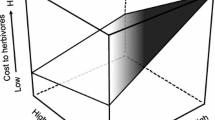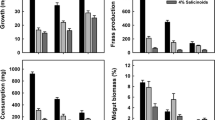Abstract
The concentration of toxins in plants can vary with plant phenology and environmental factors. Changes in toxicity may or may not be associated with changes in plant flavor. These factors may make it difficult for herbivores to avoid toxic plants. We conducted three experiments concerning animals' ability to detect toxins. In experiment 1, we examined whether animals familiar with a tastable toxin on food would adjust intake when toxin concentrations changed. Lambs were initially offered oats with either a low, medium, or high concentration of lithium chloride (LiCl; a salty-tasting toxin). Later, when all lambs were offered oats with the medium concentration of LiCl, lambs that were conditioned with the low LiCl concentration decreased intake while lambs conditioned with the high LiCl concentration increased intake. In experiment 2, we examined flavor aversions formed when animals sampled food with two flavor levels prior to illness. Lambs initially ate the same amount of barley with a low and with a high concentration of either sodium saccharin (a sweet flavor) or aluminum sulfate (a bitter flavor). Lambs then received a mild dose of LiCl. Later, when lambs were offered a choice between barley with either a low or high flavor concentration, lambs preferred the barley with the low flavor concentration. Experiment 3 examined how variable toxicity affected intake when the flavor remained constant. Lambs were initially offered oregano-flavored barley and then received a dose of LiCl. Lambs received either a medium dose, a high dose, or a dose that varied randomly among low, medium, or high amounts of LiCl. Lambs in the medium dose group ate more oregano-flavored barley at the end of the trial than did lambs in either of the other groups.
Similar content being viewed by others
References
Brattsten, L.B. 1979. Biochemical defense mechanisms in herbivores against plant allelochemicals, pp. 200–270,in G.A. Rosenthal and D.H. Janzen (eds.). Herbivores: Their Interaction with Secondary Plant Metabolites. Academic Press, New York.
Bryant, J.P., Reichardt, P.B., andClausen, T.P. 1992. Chemically mediated interactions between woody plants and browsing mammals.J. Range Manage. 45:18–24.
Burritt, E.A., andProvenza, F.D. 1989. Food aversion learning: Ability of lambs to distinguish safe from harmful foods.J. Anim. Sci. 67:1732–1739.
DuToit, J.T., Provenza, F.D., andNastis, A. 1991. Conditioned taste aversions: How sick must a ruminant get before it learns about toxicity in foods?Appl. Anim. Behav. Sci. 30:35–46.
Freeland, W.F., andJanzen, D.H. 1974. Strategies in herbivory by mammals: The role of plant secondary compounds.Am. Nat. 108:269–289.
Garcia, J. 1989. Food for Tolman: Cognition and cathexis in concert, pp. 45–85,in T. Archer and L. Nilsson (eds.). Aversions, Avoidance and Anxiety. Lawrence Erlbaum Assoc, Hillsdale, New Jersey.
Garcia, J., andHankins, W.G. 1977. On the origin of food aversion paradigms, pp. 3–26,in L. Barker, M. Domjam, and M. Best (eds.). Learning Mechanisms in Food Selection. Baylor University Press, Waco, Texas.
Harborne, J.B. 1991. The chemical basis of plant defense, pp. 45–59,in R.T. Palo and C.T. Robins (eds.). Plant Defenses Against Mammalian Herbivory. CRC Press, Boca Raton, Florida.
Laca, E.A., andDemment, M.W. 1991. Herbivory: The dilemma of foraging in a spatially heterogeneous food environment, pp. 29–44,in R.T. Palo and C.T. Robins (eds.). Plant Defenses against Mammalian Herbivory. CRC Press, Boca Raton, Florida.
Laycock, W.A., Young, J.A., andUeckert, D.N. 1988. Ecological status of poisonous plants on rangelands, pp. 27–42,in L.F. James, M.H. Ralphs, and D.B. Nielson (eds.). The Ecology and Economic Impact of Poisonous Plants on Livestock Production. Westview Press, Boulder, Colorado.
Manners, G.D., Pfister, J.A., Ralphs, M.H., Panter, K.E., andOlsen, J.D. 1992. Larkspur chemistry: Toxic alkaloids in tall larkspurs.J. Range Manage. 45:63–66.
McArthur, C., Hagerman, A.E., andRobbins, C.T. 1991. Physiological strategies of mammalian herbivores against plant defenses, pp. 103–114,in R.T. Palo and C.T. Robbins (eds.). Plant Defenses against Mammalian Herbivory. CRC Press, Boca Raton, Florida.
McKey, D. 1979. The distribution of secondary compounds within plants, pp. 56–133,in G.A. Rosenthal and D.H. Janzen (eds.). Herbivores: Their Interactions with Secondary Plant Metabolites. Academic Press, New York.
Meyer, M.W., andKarasov, W.H. 1991. Chemical aspects of herbivory in arid and semiarid habitats, pp. 167–187,in R.T. Palo and C.T. Robbins (eds.). Plant Defenses against Mammalian Herbivory. CRC Press, Boca Raton, Florida.
Molyneux, R.J., andRalphs, M.H. 1992. Plant toxins and palatability to herbivores.J. Range Manage. 45:13–18.
Nowlis, G.H. 1974. Conditioned stimulus intensity and acquired alimentary aversion in the rat.J. Comp, Physiol. Psychol. 86:1173–1184.
Provenza, F.D., andBalph, D.F. 1990. Applicability of five diet-selection models to various foraging challenges ruminants encounter, pp. 423–460,in R.N. Hughes (ed.). Behavioral Mechanisms of Food Selection. Springer-Verlag, Berlin.
Provenza, F.D., Balph, D.F., Dwyer, D.D., Ralphs, M.H., andPfister, J.A. 1988. Toward understanding the behavioral responses of livestock to poisonous plants, pp. 407–424,in L.F. James, M.H. Ralphs, and D.B. Nielsen (eds.). The Ecology and Economic Impact of Poisonous Plants on Livestock Production. Westview Press, Boulder, Colorado.
Provenza, F.D., Burritt, E.A., Clausen, T.P., Bryant, J.P., Reichardt, P.B., andDistel, R.A. 1990. Conditioned flavor aversions: A mechanism for goats to avoid condensed tannins in blackbrush.Am. Nat. 136:810–828.
Provenza, F.D., Pfister, J.A., andCheney, C.D. 1992a. Mechanisms of learning in diet selection with reference to phytotoxicosis in herbivores.J. Range Manage. 45:36–45.
Provenza, F.D.,Lynch, J.J., andNolan, J.V. 1992b. Food aversion conditioned in anesthetized sheep.J. Comp. Psychol. Submitted.
Robbins, C.T., Mole, S., Hagerman, A.E., andHanley, T.A. 1987. Role of tannins in defending plants against ruminants: Reduction in dry matter digestion?Ecology 68:1606–1615.
Scott, T.R., andGiza, B.K. 1987. A measure of taste intensity discrimination in the rat through conditioned taste aversions.Physiol. Behav. 41:315–320.
Spector, A.C., andGrill, H.J. 1988. Differences in the taste quality of maltose and sucrose in rats: Issues involving the generalization of conditioned taste aversions.Chem. Senses 13:95–113.
Author information
Authors and Affiliations
Additional information
This research was supported by the Utah Agricultural Experiment Station, Utah State University, Logan, Utah 84322. Approved as journal paper No. 4337. The research methods were approved by the Animal Care and Use Committee at Utah State University.
Rights and permissions
About this article
Cite this article
Launchbaugh, K.L., Provenza, F.D. & Burritt, E.A. How herbivores track variable environments: Response to variability of phytotoxins. J Chem Ecol 19, 1047–1056 (1993). https://doi.org/10.1007/BF00987367
Received:
Accepted:
Issue Date:
DOI: https://doi.org/10.1007/BF00987367




